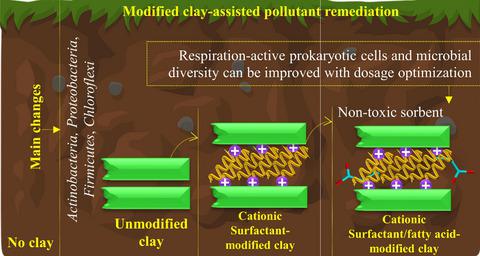当前位置:
X-MOL 学术
›
Microb. Biotechnol.
›
论文详情
Our official English website, www.x-mol.net, welcomes your
feedback! (Note: you will need to create a separate account there.)
Modified clays alter diversity and respiration profile of microorganisms in long-term hydrocarbon and metal co-contaminated soil.
Microbial Biotechnology ( IF 4.8 ) Pub Date : 2019-11-11 , DOI: 10.1111/1751-7915.13510 Bhabananda Biswas 1, 2 , Albert L Juhasz 1 , Mohammad Mahmudur Rahman 2, 3 , Ravi Naidu 2, 3
Microbial Biotechnology ( IF 4.8 ) Pub Date : 2019-11-11 , DOI: 10.1111/1751-7915.13510 Bhabananda Biswas 1, 2 , Albert L Juhasz 1 , Mohammad Mahmudur Rahman 2, 3 , Ravi Naidu 2, 3
Affiliation

|
Clays and surfactant‐modified clays (organoclays) are becoming popular as pollutant sorbents due to their high reactivity and low‐cost availability. However, the lack of field testing and data on ecotoxicity limits their application. Considering such aspects, this study assessed the impact of clay amendments to polycyclic aromatic hydrocarbons (PAHs)/cadmium (Cd)‐contaminated soil on microbial respiration profiles (active vs. inactive cells) using redox staining and the relative abundance and diversity of bacteria and archaea. These clay products are bentonite, cationic surfactant‐modified bentonite and palmitic acid‐grafted surfactant‐modified bentonite). After 70 days, the addition of bentonite and its modified forms altered microbial community structure mainly among dominant groups (Actinobacteria, Proteobacteria, Firmicutes and Chloroflexi) with effects varying depending on material loading to soil. Among amendments, fatty acid (palmitic acid) tailored cationic surfactant‐modified bentonite proved to be microbial growth supportive and significantly increased the number of respiration‐active microbial cells by 5% at a low dose of material (e.g. 1%). Even at high dose (5%), the similarity index using operational taxonomic units (OTUs) also indicates that this modified organoclay‐mixed soil provided only slightly different environment than control soil, and therefore, it could offer more biocompatibility than its counterpart organoclay at similar dose (e.g. cationic surfactant‐modified bentonite). This study promotes designing ‘eco‐safe’ clay‐based sorbents for environmental remediation.
中文翻译:

改性粘土改变了长期被碳氢化合物和金属共同污染的土壤中微生物的多样性和呼吸特性。
粘土和经表面活性剂改性的粘土(有机粘土)因其高反应性和低成本可获得性而成为污染物吸附剂。但是,缺乏现场测试和有关生态毒性的数据限制了它们的应用。考虑到这些方面,本研究使用氧化还原染色评估了粘土改性剂对多环芳烃(PAHs)/镉(Cd)污染土壤对微生物呼吸谱(活性与非活性细胞)的影响以及细菌和细菌的相对丰度和多样性。古细菌。这些粘土产品是膨润土,阳离子表面活性剂改性的膨润土和棕榈酸接枝的表面活性剂改性的膨润土。70天后,膨润土及其修饰形式的添加主要在优势群体(放线菌,变形杆菌,菌群和绿叶弯曲菌),其效果因土壤中的物料负载而异。在修正案中,脂肪酸(棕榈酸)量身定制的阳离子表面活性剂改性膨润土被证明具有微生物生长支持作用,并且在低剂量(例如1%)的情况下,呼吸活性微生物细胞的数量显着增加了5%。即使在高剂量(5%)下,使用操作分类单位(OTU)的相似性指数也表明,这种改性的有机粘土混合土壤仅提供与对照土壤略有不同的环境,因此,与土壤中的同类有机粘土相比,它可以提供更多的生物相容性。剂量相似(例如阳离子表面活性剂改性的膨润土)。这项研究促进设计用于环境修复的“生态安全”粘土基吸附剂。
更新日期:2019-11-11
中文翻译:

改性粘土改变了长期被碳氢化合物和金属共同污染的土壤中微生物的多样性和呼吸特性。
粘土和经表面活性剂改性的粘土(有机粘土)因其高反应性和低成本可获得性而成为污染物吸附剂。但是,缺乏现场测试和有关生态毒性的数据限制了它们的应用。考虑到这些方面,本研究使用氧化还原染色评估了粘土改性剂对多环芳烃(PAHs)/镉(Cd)污染土壤对微生物呼吸谱(活性与非活性细胞)的影响以及细菌和细菌的相对丰度和多样性。古细菌。这些粘土产品是膨润土,阳离子表面活性剂改性的膨润土和棕榈酸接枝的表面活性剂改性的膨润土。70天后,膨润土及其修饰形式的添加主要在优势群体(放线菌,变形杆菌,菌群和绿叶弯曲菌),其效果因土壤中的物料负载而异。在修正案中,脂肪酸(棕榈酸)量身定制的阳离子表面活性剂改性膨润土被证明具有微生物生长支持作用,并且在低剂量(例如1%)的情况下,呼吸活性微生物细胞的数量显着增加了5%。即使在高剂量(5%)下,使用操作分类单位(OTU)的相似性指数也表明,这种改性的有机粘土混合土壤仅提供与对照土壤略有不同的环境,因此,与土壤中的同类有机粘土相比,它可以提供更多的生物相容性。剂量相似(例如阳离子表面活性剂改性的膨润土)。这项研究促进设计用于环境修复的“生态安全”粘土基吸附剂。











































 京公网安备 11010802027423号
京公网安备 11010802027423号